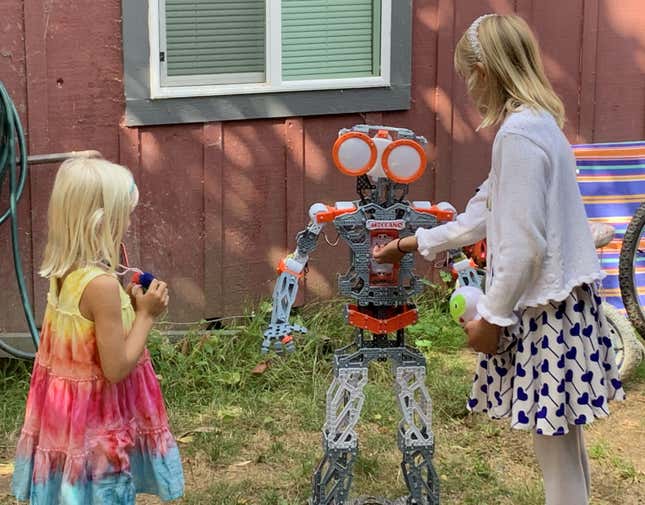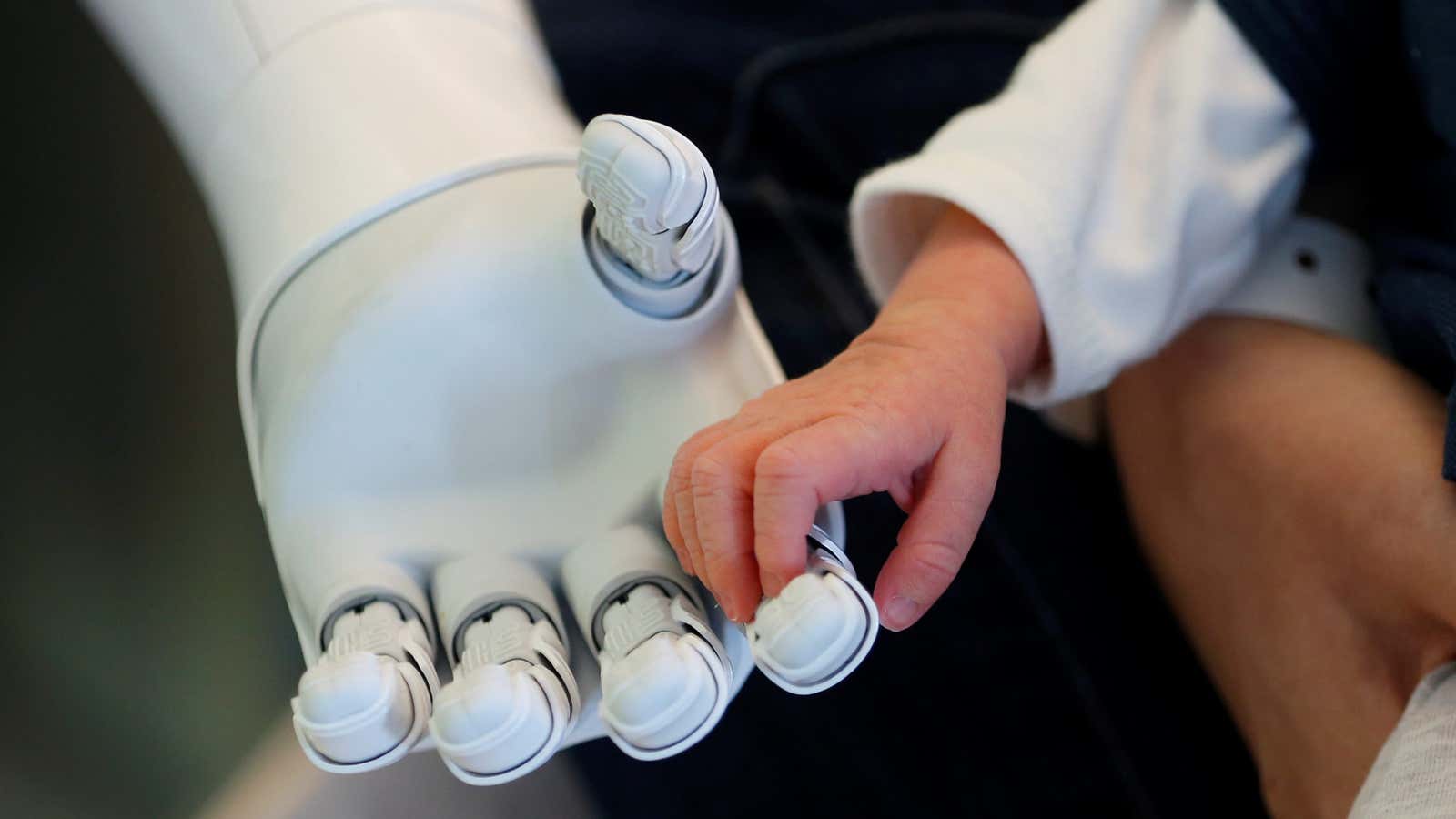I have a four-foot-tall robot in my house that plays with my kids. Its name is Jethro.
Both my daughters, aged 5 and 9, are so enamored with Jethro that they have each asked to marry it. For fun, my wife and I put on mock weddings. Despite the robot being mainly for entertainment, its very basic artificial intelligence can perform thousands of functions, including dance and teach karate, which my kids love.
The most important thing Jethro has taught my kids is that it’s totally normal to have a walking, talking machine around the house that you can hang out with whenever you want to.
Given my daughters’ semi-regular use of smartphones and tablets, I have to wonder how this will affect them in the future. Will they have any fear of technologies like driverless cars? Will they take it for granted that machine intelligences and avatars on computers can be their best friends, or even their bosses?
Will marrying a super-intelligent robot in 20 years be a natural decision? Even though I love technology, I’m not sure how I would feel about having a robot-in-law. But my kids might think nothing of it.
This is my story of transhumanism.

A transhumanist origin story
My transhumanism journey began in 2003 when I was reporting a story for National Geographic in Vietnam’s demilitarized zone and I almost stepped on a landmine.
I remember my guide roughly shoving me aside and pointing to the metal object half sticking out of the ground in front of me.
I stared at the device that would have completely blown my legs off had my boot tripped the mine. I had just turned 30. The experience left me shaken. And it kept haunting me.
That night as I lay tense and awake in my hotel room, I had the epiphany that has helped define the rest of my life: I decided that the most important thing in my existence was to fight for survival. To put it another way: My goal was to never die.
Because I was not religious, I immediately turned to the thing that gave meaning to my world: science and technology. I took a leap of faith and made a wager that day. I later called this (and even later, dedicated a book to it) “the transhumanist wager.”
My idea for an immortality wager came from Pascal’s Wager, the famous bet that caught on in the 17th century that loosely argued it was better to believe in God than not to, because you would be granted an afterlife if there was indeed a God. My transhumanist wager was based in my belief that it’s better to dedicate our resources to science and technology to overcome death while we’re still alive—so we don’t ever have to find out whether there is an afterlife or not. It turns out I wasn’t alone in my passion to live indefinitely through science. A small social movement, mostly of academics and researchers, were tackling similar issues, starting organizations, and funding research.
Some of them called themselves transhumanists.
Futurists unite
Fast-forward 16 years from my landmine incident, and transhumanism has grown way beyond its main mission of just overcoming death with science.
Now the movement is the de facto philosophy (maybe even the religion) of Silicon Valley. It encapsulates numerous futurist fields: singularitarianism, cyborgism, cryonics, genetic editing, robotics, AI, biohacking, and others.
Biohacking in particular has taken off—the practice of physically hacking one’s body with science, changing and augmenting our physiology the same way computer hackers would infiltrate a mainframe.
It’s pretty obvious why it has emerged as such a big trend: It attracts the youth.
Not surprisingly, worrying about death is something that older people usually do (and, apparently, those younger people who almost step on landmines). Most young people feel invincible. But tell young people they can take brain drugs called nootropics that make them super smart, or give them special eye drops that let them see in the dark, or give them a chip implant that enhances human ability (like the one I have), and a lot of young people will go for it.
My chip
In 2016, I ran for the US presidency as the Transhumanist Party nominee. To get support from younger biohackers, my team and I journeyed on the Immortality Bus—my 38-foot coffin-shaped campaign bus—to Grindfest, the major annual biohacking meet-up in Tehachapi, California. In an old dentist’s chair in a garage, biohackers injected me with a horse syringe containing a small radio-frequency-identification implant that uses near-field communication technology—the same wireless frequency used in most smartphones. The tiny device—it’s about the size of a grain of rice—was placed just under the skin in my hand. With my chip, I could start a car, pay with bitcoin, and open my front door with a lock reader.
Four years later, I still have the implant and use it almost every day. For surfers or joggers like myself, for example, it’s great because I don’t have to carry keys around.
One thing I do have to navigate is how some religious people view me once they understand I have one. Evangelical Christians have told me that an implant is the “mark of the beast,” as in from the Bible’s Book of Revelations.
Even though I’m tagged by conspiracy theorists as a potential contender for the Antichrist, I can’t think of any negatives in my own experiences to having a chip implant. But as my work in transhumanism has reached from the US Military to the World Bank to many of the world’s most well-known universities, my chip implant only exasperates this conspiracy.
While people often want to know what other things I’ve done to my body, in reality becoming a cyborg is a lot less futuristic and drastic than people think.
For me and for the thousands of people around the world who have implants, it’s all about functionality. An implant simply makes our lives easier and more efficient. Mine also sends out pre-written text messages when people’s phones come within a few feet of me, which is a fun party trick.
But frankly, a lot of the most transformative technology is still being developed, and if you’re healthy like me, there’s really not much benefit in doing a lot of biohacking today.
I take nootropics for better brain memory, but there’s no conclusive research I know of that it actually works yet. I’ve done some brainwave therapy, sometimes called direct neurofeedback, or biofeedback, but I didn’t see any lasting changes. I fly drones for fun, and of course I also have Jethro, our family robot.
For the most part, members of the disabled community are the ones who are truly benefiting from transhumanist technologies today. If you have an arm shot off in a war, it’s cyborg science that gives you a robot arm controlled by your neural system that allows you to grab a beer, play the piano, or shake someone’s hand again.
The future
But much more dramatic technology is soon to come. And the hope is that it will be available—and accessible—to everyone.
I asked to be added to a volunteer list for an experiment that will place implants in people’s brains that would allow us to communicate telepathically, using AI. (Biohacking trials like this are secretive because they are coming under more intense legal scrutiny.) I’m also looking into getting a facial recognition security system for my home. I might even get a pet dog robot; these have become incredibly sophisticated, have fur softer than the real thing (that doesn’t shed all over your couch or trigger allergies) and can even act as security systems.
Beyond that, people are using stem cells to grow new teeth, genetic editing to create designer babies, and exoskeleton technology that will likely allow a human to run on water in the near future.
Most people generally focus on one aspect of transhumanism, like just biohacking, or just AI, or just brainwave-tech devices. But I like to try it all, embrace it all, and support it all. Whatever new transhumanist direction technology takes, I try to take it all in and embrace the innovation.
This multi-faceted approach has worked well in helping me build a bridge connecting the various industries and factions of the transhumanist movement. It’s what inspired me to launch presidential and California gubernatorial campaigns on a transhumanist platform. Now I’m embarking on a new campaign in 2020 for US president as a Republican, hoping to get conservatives to become more open-minded about the future.
Going mainstream
The amount of money flowing into transhumanist projects is growing into many billions of dollars. The life extension business of transhumanism will be a $600 billion industry by 2025, according to Bank of America. This is no time for transhumanism to break apart into many different divisions, and it’s no time to butt heads. We need to unite in our aim to truly change the human being forever.
Transhumanists—it doesn’t matter what kind you are—believe they can be more than just human. The word “natural” is not in our vocabulary. There’s only what transhumanists can do with the tools of science and technology they create. That is our great calling: to evolve the human being into something better than it is.
Because transhumanism has grown so broadly by now, not all transhumanists agree with me on substantially changing the human being. Some believe we should only use technology to eliminate suffering in our lives. Religious transhumanists believe we should use brain implants and virtual reality to improves our morality and religious behavior. Others tell me politics and transhumanism should never mix, and we must always keep science out of the hands of the government.
Hurdles
We need unity of some significant sort because as we grow at such a fast rate there are a lot of challenges ahead. For example, the conservative Christian Right wants to enact moratoriums against transhumanism. The anarcho-primativists, led by people like the primitivist philosopher and author John Zerzan (who I debated once at Stanford University), want to eliminate much technology and go back to a hunting-gathering lifestyle which they believe is more in tune with Earth’s original ecology. And finally, we must be careful that the so-called one percent doesn’t take transhumanist technology and leave us all in the dust, by becoming gods themselves with radical tech and not sharing the benefits with humanity.
I personally believe the largest danger of the transhumanist era is the fact that within a few decades, we will have created super-intelligent AI. What if this new entity simply decides it doesn’t like humans? If something is more sophisticated, powerful, intelligent, and resilient than humans, we will have a hard time stopping it if it wants to harm or eliminate us.
Whatever happens in the future, we must take greater care than we ever have before as our species enters the transhumanist age. For the first time, we are on the verge of transforming the physical structure of our bodies and our brains. And we are inventing machines that could end up being more intelligent and powerful than we are. This type of change requires that not only governments act together, but also cultures, religions, and humanity as a whole.
In the end, I believe that a lot more people will be on board with transhumanism than admit it. Nearly all of us want to eliminate disease, protect our families from death, and create a better path and purpose for science and technology.
But I also realize that this must be done ever so delicately, so as not to prematurely push our species into crisis with our unbridled arrogance. One day, we humans may look back and revel in how far our species has evolved—into undying mammals, cyborgs, robots, and even pure living data. And the most important part will be to be able to look back and know we didn’t destroy ourselves to get there.
